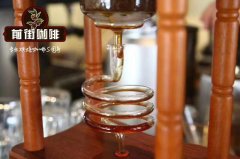Which producing area does sulawesi coffee bean come from? which coffee bean has the best flavor in the world?

Professional coffee knowledge exchange more coffee bean information please follow the coffee workshop (Wechat official account cafe_style)
So what is the best coffee bean? Of course, what suits you best is the best, but this sentence looks like nonsense. If you haven't drunk enough coffee or tried enough varieties, how do you know which one is right? Is the item that you have been drinking for a long time necessarily the most suitable? Look at the flavor description of the words like it must be suitable for the taste?
Coffee from Sulawesi can be Indonesian jewelry. All the coffee produced here comes from Tibica old tree, and the unique wet processing makes the raw coffee beans here appear as a unique dark cyan large-grained coffee. Low acidity, high mellowness, and clean overall style are all characteristics of Sulawesi coffee. The boutique coffee here is grown on a small family farm at an altitude of 1600-1800 meters. Its unique rustic flavor, herbal aroma and honey-like aftertaste can be found in Sulawesi boutique coffee.
Sulawesi Toarco no longer wet production country: Indonesia grade: no planting area: Sulawesi Toraya factory label: Toarco no more plantation
Treatment method: wet processing appearance: 2dmax 300grgrgr18SCR variety: Sumatra variety
Coffee bean selection
Coffee beans
The principle that will never change, buy coffee beans (whole beans). Coffee powder is very convenient, but in order to save such a little time, it is not worth it, the taste is really too bad. Air is the enemy of coffee, which begins to oxidize when it is ground into powder, meaning the taste dissipates more quickly. The closer you get to grinding beans when you brew coffee, the fresher and more fragrant it is.
Baking date
The first element is that the baking date is completely different from the "shelf life". Although it feels like coffee can be kept indefinitely, this is not the case. Of course, if you drink coffee beans for a year, you may not get sick. Coffee beans may not be too "bad", but they are definitely not that good.
When the coffee bean is roasted, its chemical composition begins to change immediately. Coffee beans begin to emit carbon dioxide from roasting, a process known as "degassing" in English. When the coffee beans begin to exhaust, the oil in the beans will begin to oxidize, indicating that the flavor of the beans will begin to decline. The freshness of coffee beans is subjective, but the recommended coffee beans are consumed from four days to two weeks after roasting, but how the coffee is extracted can also affect this period.
For example, if you like to use it by hand, it is recommended to start using it in the first week after baking, and the sooner you use it, the better, because the flavor and aroma of coffee is the most perfect and complete at this time. But if you like to make espresso (coffee maker), the beans can be "kept" for a little longer, about seven to nine days before you start using them. If you leave it a little longer, it will be suitable for making cold coffee.
Place of Origin
Altitude, soil, rainfall and sunlight all contribute to the final taste of coffee beans, so the origin of coffee beans is an important indicator of how they are tasted. Coffee trees thrive along the "coffee bean belt", which is the area between the Tropic of Cancer and the North. If your coffee bag or barista can't tell you where this bag of coffee is grown, you may need to reconsider your options.
Coffee is produced in more than 60 countries around the world, but it's better to start with some famous producing areas and learn about their flavor characteristics before switching to more exotic varieties. In countries such as Hawaii, Brazil, Ethiopia, Kenya and so on, you can first understand the characteristics of each producing area and see which flavor you prefer.
Between the extremely unique climate and processing technology, exploring the flavor of coffee according to the region is a great enjoyment. Even if you already have one or two favorite producing areas, it is recommended to try different producing areas once in a while to discover something new.
END
Important Notice :
前街咖啡 FrontStreet Coffee has moved to new addredd:
FrontStreet Coffee Address: 315,Donghua East Road,GuangZhou
Tel:020 38364473
- Prev

What is arusha coffee?| How does the arusha blue mountain coffee variety taste?
Professional coffee knowledge exchange More coffee bean information, please pay attention to coffee workshop (Weixin Official Accounts cafe_style) First of all, Arabica series in addition to Bourbon and Kent main varieties, there are Tibika, Blue Mountain, Arusha. And then there's Robusta. 450,000 smallholder farmers in productive farming systems depend on coffee (locally known as kahawa) for their livelihoods. These five hectare plots
- Next

Which country is Toraya coffee | introduction to the flavor of civet coffee Tanatolaya coffee
Professional Coffee knowledge Exchange more information about coffee beans Please follow the coffee workshop (Wechat official account cafe_style) for many people around the world today, coffee is more than just a morning drink. It is regarded as a personal culture and way of life. From cheap instant coffee to a mysterious and exquisite cup of black gold coffee, coffee lovers around the world wake up in the morning to talk about coffee
Related
- Beginners will see the "Coffee pull flower" guide!
- What is the difference between ice blog purified milk and ordinary milk coffee?
- Why is the Philippines the largest producer of crops in Liberia?
- For coffee extraction, should the fine powder be retained?
- How does extracted espresso fill pressed powder? How much strength does it take to press the powder?
- How to make jasmine cold extract coffee? Is the jasmine + latte good?
- Will this little toy really make the coffee taste better? How does Lily Drip affect coffee extraction?
- Will the action of slapping the filter cup also affect coffee extraction?
- What's the difference between powder-to-water ratio and powder-to-liquid ratio?
- What is the Ethiopian local species? What does it have to do with Heirloom native species?

